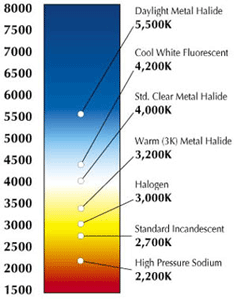Color temperature is a measurement that indicates the extent of a yellowish or bluish tint to white light. High color temperatures are bluish while low color temperatures are yellowish. Of interest is that human vision compensates for these tints, and perceives both high and low color temperature lights as being white. It is only when two sources of different color temperatures are side-by-side that they appear different. There are, however, other subtle effects of these differences discussed in this article.
This measurement began in the late 1800s when William Kelvin experimented with heat and a block of carbon. As the carbon heated, he noticed that it produced an array of colors as the temperature was increased. The heated carbon block first produced dim red light and eventually a bright blue-white glow as higher temperatures were achieved. He noticed that with lower temperatures, most of the energy was converted to heat.
Why Does Color Temperature Matter?
 Color temperature is particularly important in the lighting industry where differences in color temperature can affect how color is rendered and ultimately the mood and emotional impact of a room or environment. Lighting that is described as warm or cool is ironically actually quite the opposite on the Kelvin color temperature scale.
Color temperature is particularly important in the lighting industry where differences in color temperature can affect how color is rendered and ultimately the mood and emotional impact of a room or environment. Lighting that is described as warm or cool is ironically actually quite the opposite on the Kelvin color temperature scale.
The supposed warm lights have a lower color temperature, while cool lights have a higher color temperature. Lower Kelvin numbers indicate that a light source appears more yellow; higher Kelvin numbers mean the light is whiter or bluer. Warm and cool lighting is an industry term that doesn’t refer to the color temperature of lighting but rather the psychological characteristics of it.
Color temperature is often an aesthetic choice that depends on location and application. VOLT® LED bulbs are available in a variety of color temperatures – cool bright whites to warm yellows. Here is a list of the most popular color temperatures of LED lighting and their typical applications.
- Very Warm White (2200K). This is the lowest possible color temperature for white light (any lower is yellow light!) Also referred to as candlelight, this is used for very romantic, low key settings such as around outdoor fireplaces and hot tubs. It is also similar to High-Pressure Sodium (HPS) commonly used for street lights, and less commonly for 120v moonlighting.
- Warm White (2700K). Similar to halogen-type landscape lighting, it is the most preferred color temperature for landscape lighting. Psychologically, it is thought to be more welcoming and soothing compared to higher color temperatures.
- Warm or Natural White (3000K). Noticeably cooler than 2700K, some landscape lighting pros prefer this temperature. It tends to accentuate greens and blues in vegetation.
- Cool White (4000K). Quite bluish compared to 2700K, this is sometimes used to illuminate blue vegetation (such as blue spruce). It is also used to simulate moonlight (4200K).
VOLT® offers LED bulbs in all the above color temperatures so you can select the color that you prefer.






